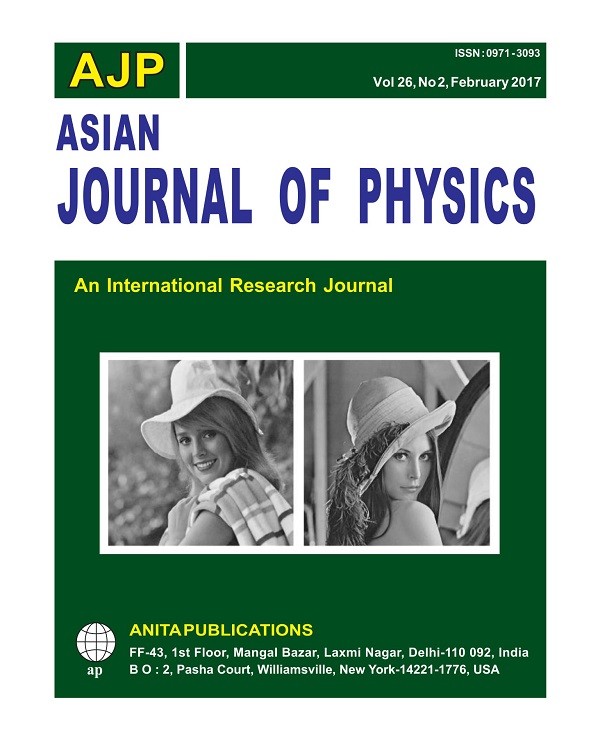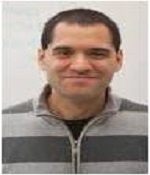Editor-in-Chief : V.K. Rastogi

ASIAN JOURNAL OF PHYSICS
An International Peer Reviewed Research Journal
Frequency : Monthly,
ISSN : 0971 – 3093
Editor-In-Chief (Hon.) :
Dr. V.K. Rastogi
e-mail:[email protected]
[email protected]
| AJP | ISSN : 0971 – 3093 Vol 26, No 2, February, 2017 |
Guest Editorial

Three-dimensional imaging is used in a plethora of domains, such as 3D nonintrusive testing of cracks and fatigue in equipment, defect inspection, precision measurements, the monitoring of automated processes, 3D particle image velocimetry, 3D stress and deformation measurement, 3D microscopy of transparent phase objects for biomedical imaging, and holographic displays for the entertainment industry, just to name a few.
This special issue of Asian J Phys will focus on the latest advances in interferometric and non-interferometric 3D imaging techniques and applications in the fields of metrology and 3D displaysas applied to various industries, with particular emphasis on practical applications in biomedicine, biophotonics, and scientific and optical inspection.
Scientific and technology innovations are the main motivations for this special issue. Authors were encouraged to give full and in-depth descriptions of the concept, theory, mathematical model, experimental system, and experimental results.

Based on the classification of topics, we have attempted to organize the papers into the following categories: 3D phase retrieval based on the Transport of Intensity equation, holographic displays, fringe projection profilometry, and applications of photorefractive materials in 3D imaging.
An important area of applications of 3D imaging is in metrology and profilometry. Latest advances in fast tomographic 3D phase retrieval using the noninterferometric transport of intensity equation technique were discussed in this issue. In coherent interferometric techniques, the use of the reference beam allows for the recording of the phase of the object. The interferometric systems are bulky, sensitive to perturbations, and they require phase unwrapping which may introduce artifacts in the reconstructed 3D image. However, the phase and the amplitude of the optical field radiated from an object are interrelated during propagation, and they obey the transport of intensity (TI) equation. Thus, in this non-interferometric technique, it is possible to obtain the phase distribution of the object if the intensity is recorded at different planes during the propagation of the diffracting optical field. In this work, we discuss the latest advances in fast tomographic 3D phase retrieval technique using the TI equation which uses either a tunable lens or a spatial light modulator (SLM) to replace the slow mechanical translation of the CCD. These novel TIE configurations are suitable for dynamical events such as imaging biological processes.
Another important aspect is the partial coherence in the transport of intensity phase imaging. For both coherent and partially coherent light, the TIE is equivalent to a continuity equation relating intensity changes upon propagation to a flux vector describing the flow of intensity, which for stationary fields is equivalent to energy conservation. The TIE enables the recovery of flux from intensity measurements. For coherent fields, this flux is proportional to the gradient of the field’s phase and therefore, the retrieved flux can be used to retrieve phase. For partially coherent light, the field has no analogue to phase. Instead, one can retrieve the thickness of samples that are illuminated by partially coherent light provided the coherence effects are taken into account. In this issue, we review two methods to do so for general states of coherence where additional measurements are required to characterize both the illumination and the sample and for Kohler illumination where partial coherence manifests as a blurring of the recovered phase. This blurring effect can be compensated for by deconvolution methods.This blurring effect can be compensated for by deconvolution methods.
A fundamental advantage of holography is that it enables 3D imaging and display. A holographic display based on complex wavefront modulation was proposed. Complex wavefront modulation is realized by double phases and Fourier filter. The optimized filter is proposed to suppress the noise and improve the accuracy of the complex modulation. The modulated beam by single phase-only spatial light modulator passes through a 4f optical system to synthesize the expected complex modulated wavefront on the output plane, with an appropriate spatial filter in the Fourier plane. The proposed spatial filter structure is efficient for the realization of complex wavefront modulation with a phase-only modulator. The performance of holographic display is also improved by complex wavefront modulation, compared with the holographic display based on phase-only wavefront modulation. The proposed encoding and display technique is theoretically demonstrated, as well as validated in numerical simulations. The proposed encoding method, avoiding the iteration calculation, can be more suitable for dynamic holography display.
One of the standard techniques used for 3D metrology in industry is based on fringe projection profilometry. A comparative analysis and implementation of a low cost, portable, and full field of view fringe projection profilometry imaging system was discussed in details using off-the-shelf components. The constructed system is equipped with different recording and reconstruction capabilities depending on the user’s constraints of accuracy, speed, and portability. A detailed comparative analysis and complete discussion of all the different steps of the recording and reconstruction process of the FFOV-FPP imaging system is conducted. Specifically, fringe analysis, phase error compensation methods, and spatial and temporal phase unwrapping is discussed in details. A 3D image fusion using an iterative closest point (ICP) algorithm for a FFOV reconstruction was also developed Experimental results at each step of the process will be shown and the accuracy of the system is discussed.
Recording materials based on photorefractive effect applied to the area of 3D imaging was also discussed. Photorefractive (PR) materials have been used in numerous applications over the last five decades especially in the field of holography. The underlying theory has been developed with various approximations of the Kukhtarev equations which model the PR material. Propagation of optical waves through a PR material demands the solutions of the coupled set of material equation and the wave equation. In this paper, two aspects of PR materials that can result in potential applications were summarized. The first pertains to propagation of beams through a PR material and simultaneous generation of higher orders, with potential applications in the area of dynamic phase shifting digital holography. The second is the resulting mechanical deformation of the material due to a combination of the PR and piezoelectric effect, which can have potential applications in the area of hybrid PR structures.
It is hoped that this feature issue on 3D imaging excites readers to pursue further developments in the area and opens the door to exciting applications.
George Nehmetallah
EECS Department, The Catholic University of America, Washington DC 20064, USA
Jonathan Petruccelli
Department of Physics, Univ. at Albany- State Univ. of New York, 1400 Washington Avenue, Albany, NY 12222, USA
|
Asian Journal of Physics |
Vol. 26 No 1 (2017) 71-93 |
Latest advances in fast tomographic 3D phase retrieval using the TI equation
George Nehmetallah* and Thanh Nguyen
EECS Department, The Catholic University of America,
Washington DC 20064, USA
Coherent interferometric techniques rely on the use of the reference beam to record the phase of the object. The interferometric systems are bulky, sensitive to perturbations, and they require phase unwrapping which may introduce artifacts in the reconstructed 3D image. However, the phase and the amplitude of the optical field radiated from an object are interrelated during propagation, and they obey the transport of intensity (TI) equation. Thus, in this non- interferometric technique, it is possible to obtain the phase distribution of the object if the intensity is recorded at different planes during the propagation of the diffracting optical field. In this work, we discuss the latest advances in fast tomographic 3D phase retrieval technique using the TI equation which does not suffer from the drawbacks of interferometric techniques. The optical setup is based on a 4f configuration which uses either a tunable lens or a spatial light modulator (SLM) to replace the slow mechanical translation of the CCD required to record several diffraction patterns in a traditional TIE system. The tomographic reconstruction algorithm discussed here is based on the Fourier slice theorem which applies to objects with a small refractive index variation like biological samples. Theory, simulation, and experimental results of each configuration are discussed in details. These novel TIE configurations are suitable for dynamical events such as imaging biological processes. © Anita Publications. All rights reserved.
Keywords: Transport of intensity, Noninterferometric three-dimensional sensing, Three-dimensional microscopy, Tomography, Backprojection, Spatial light modulator, Tunable lens.
Total Refs : 36
Latest advances in fast tomographic 3D phase retrieval using the TI equation.pdf
George Nehmetallah and Thanh Nguyen
|
Asian Journal of Physics |
Vol. 26 No 1 (2017) 95-116 |
Comparative analysis and implementation of a low cost, portable, and full field of view fringe projection profilometry imaging system
Anh Thai, Dat Tran, Thanh Nguyen, and George Nehmetallah*
EECS Department, The Catholic University of America, Washington DC 20064, USA
In this work, an automated, portable, optimized, tabletop, low cost, and full field of view (FFOV) 3D scanning system based on fringe projection profilometry (FPP) using off-the-shelf components is constructed. A graphical user interface (GUI) to control, automate, and synchronize the whole FFOV-FPP system is developed. The constructed system is equipped with different recording and reconstruction capabilities depending on the user’s constraints of accuracy, speed, and portability. A detailed comparative analysis and complete discussion of all the different steps of the recording and reconstruction process of the FFOV-FPP imaging system is conducted. Specifically, fringe analysis, phase error compensation methods, and spatial and temporal phase unwrapping is discussed in details. Two dimensional image registration is used to attach the real texture to the computed height profile and a 3D image fusion using an iterative closest point (ICP) algorithm for a FFOV reconstruction will also be developed as part of this work. Experimental results at each step of the process will be shown and the accuracy of the system is discussed. © Anita Publications. All rights reserved.
Keywords: Instrumentation measurement and Metrology, Three-dimensional sensing, Three-dimensional image acquisition, Fringe Projection, Structured lighting.
* Corresponding author: [email protected]
Total Refs: 33
Comparative analysis and implementation of a low cost….pdf
Anh Thai, Dat Tran, Thanh Nguyen and George Nehmetallah
|
Asian Journal of Physics |
Vol. 26 No 1 (2017) 117-124 |
Holographic display based on complex wavefront modulation
Dezhao Kong1,2, Xueju Shen2, Liangcai Cao1,*, Hao Zhang1, and Guofan Jin1
1State Key Laboratory of Precision Measurement Technology and Instruments, Tsinghua University, Beijing, China
2Department of Electronics and Optics, Mechanical Engineering College, Shijiazhuang, China
A holographic display method based on complex wavefront modulation is proposed. Complex wavefront modulation is realized by double phases and Fourier filter. The modulated beam by single phase-only spatial light modulator passes through a 4f optical system to synthesize the expected complex modulated wavefront on the output plane, with an appropriate spatial filter in the Fourier plane. Then holographic display is achieved due to complex wavefront modulation. The proposed spatial filter structure is efficient for the realization of complex wavefront modulation with a phase-only modulator. The performance of holographic display is also improved by complex wavefront modulation, compared with the holographic display based on phase-only wavefront modulation. The proposed encoding and display technique is theoretically demonstrated, as well as validated in numerical simulations. © Anita Publications. All rights reserved.
Keywords: holography; computer-generated hologram; complex amplitude modulation.
Total Refs : 21
Holographic display based on complex wavefront modulation.pdf
Dezhao Kong, Xueju Shen, Liangcai Cao, Hao Zhang and Guofan Jin
|
Asian Journal of Physics |
Vol. 26 No 1 (2017) 125-134 |
Partial coherence in transport of intensity phase imaging
Jonathan C. Petruccelli and Tonmoy Chakraborty
Department of Physics, University at Albany – State University of New York,
1400 Washington Avenue, Albany, NY 12222, USA
Transport of intensity phase imaging is a method of propagation-based quantitative phase retrieval that utilizes short propagation distances to reduce the phase retrieval problem to a deterministic, linear equation. As usually formulated, the phase of a coherent field can be recovered by taking three or more intensity measurements through focus. However, for partially coherent light the field has no analogue to phase. Instead, one can retrieve the thickness of samples that are illuminated by partially coherent light provided the coherence effects are taken into account. Here we review two methods to do so for general states of coherence where additional measurements are required to characterize both the illumination and the sample and for Köhler illumination where partial coherence manifests as a blurring of the recovered phase.
Total Refs: 23
Partial coherence in transport of intensity phase imaging.pdf
Jonathan C Petruccelli and Tonmoy Chakraborty
|
Asian Journal of Physics |
Vol. 26 No 1 (2017) 137-145 |
Selected recent advances in the theory and applications of photorefractive materials
Partha P Banerjee1,2, Ujitha Abeywickrema1 and Akash Kota2
1Department of Electro-Optics and Photonics, University of Dayton, Dayton, OH 45469, USA
2Department of Electrical and Computer Engineering, University of Dayton, Dayton, OH 45469, USA
Over the past fifty years, photorefractive (PR) materials have been used to various applications such as holographic data storage, non destructive testing. Propagation of electromagnetic waves inside a photorefractive material can be obtained by solving a set of coupled equations and the wave equation. The purpose of this paper is to summarize two aspects of photorefractive materials which can be used in various applications. First, the generation of higher orders inside a photorefractive material is simulated using MATLAB®. These higher orders can be used for dynamic phase shifting holography. When an optical field is applied to a photorefractive material it is deformed due to the PR effect and piezoelectric effect. As the second aspect, this mechanical deformation is discussed which can be applied in the area of hybrid PR structures.© Anita Publications. All rights reserved.
Keywords: Photorefractive materials;Holographic data, Piezoelectric effect.
Total Refs : 17
Selected recent advances in the theory and applications of photorefractive materials.pdf
Partha P Banerjee Ujitha Abeywickrema and Akash Kota
